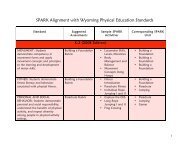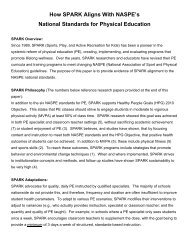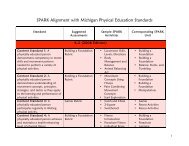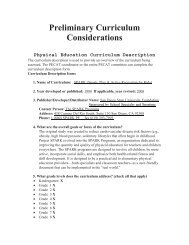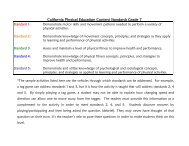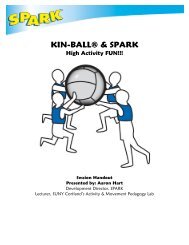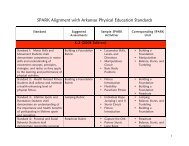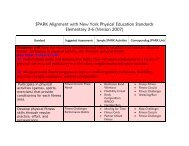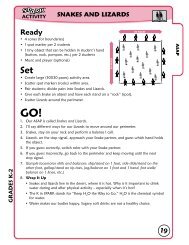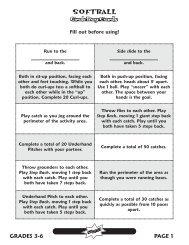Sample Text for Grant Writers - Spark Physical Education
Sample Text for Grant Writers - Spark Physical Education
Sample Text for Grant Writers - Spark Physical Education
You also want an ePaper? Increase the reach of your titles
YUMPU automatically turns print PDFs into web optimized ePapers that Google loves.
promote health behaviors: an in<strong>for</strong>mational component to increase knowledge, a component to teachself-regulatory skills, a component to increase self-efficacy (confidence level) in self-regulatory skills,and a component to increase social support <strong>for</strong> behavior change. HKC actively pursued this model whendesigning the program model and all four components are enacted through the HKC “Hear, See, Do”methodology.Studies present evidence of success with the following variables which are components of HKCprograms:• Nutrition in<strong>for</strong>mation. The type of in<strong>for</strong>mation provided to participants in order to increaseknowledge and facilitate motivation is critical. In<strong>for</strong>mation that is understandable, personallyand culturally relevant, and that increases one’s knowledge about the particular behaviorsassociated with poor health outcome is more helpful than general health in<strong>for</strong>mation (e.g.,prevalence or etiology of a particular disease) (Fisher & Fisher, 2000).• Self-regulatory. Teaching self-regulatory skills is an important component. Teaching selfregulatoryskills can be accomplished by providing social models who themselves are successfulat engaging in healthy behaviors. Increasing self-efficacy about the ability to apply these skills ineveryday life can solidify these skills.• Self-efficacy (confidence in being able to achieve wellness goals). Teaching self-efficacy involvehaving children understand realistic goal setting and rehearse or practice the behaviors that leadto the ability to practice health promoting behaviors.• Social support. Components of the social cognitive theory have been widely applied and testedamong community and school-based interventions designed to promote health behaviors inchildren and adolescents (Botvin, Eng, & Williams, 1980; Perry, Kelder, & Klepp, 1994; Perry,Killen, Telch, Slinkar, & Danaher, 1980). An extensive body of research has documented thatself-efficacy is an important mediator of health behavior (e.g., Colleti, Supnick, & Payne, 1985;Condiotte & Lichtestein, 1981; Holman & Lorig, 1992; Strecher, DeVellis, Becker, & Rosenstock,1986). Thus, although the model itself is difficult to test (Fisher & Fisher, 2000), empiricalsupport <strong>for</strong> components of the model and the usefulness of the model in designing healthpromotion programs is well documented.In addition, HKC incorporates the components of comprehensive, coordinated school health educationadvocated by Centers <strong>for</strong> Disease Control and Prevention and National Association of State Boards of<strong>Education</strong> and others:• Advocates <strong>for</strong> comprehensive school health education suggest that in addition to developinghealth curriculum, school-based health services, and health-enhancing environments,comprehensive programs also need to include the development of health policy, communitypartnerships, providing healthy food services, offering counseling, providing physical education,and offering health promotion <strong>for</strong> staff and faculty (Allensworth & Kolbe, 1987). In this light,HKC has positioned itself as a flexible and broad-based intervention that aims to give kids accessto health in<strong>for</strong>mation and healthy role models in all aspects of the community to encouragehealthy living as a habit. HKC has worked to incorporate education and encouragement ofteacher and staff health choices in order to truly alter the attitudes and behaviors of thecommunity interacting with the children.3. ResultsPage 42Back to Topwww.sparkpe.org| 1 800 SPARK PE | spark@sparkpe.org | SPARKprograms | SPARK_Programs



